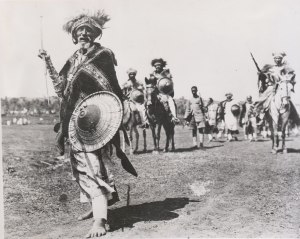This photograph was taken by H. V. Drees, a photographer with Acme photographs, who was with Ethiopian troops in the South of the country during the invasion of their country by Italy in 1935. He took many photographs which were used extensively by the American press.
This image carries this caption: “Lords of the desert. Desert nobels chanting their war cry as they trek across the Ogaden desert for the front. They are part of the irregular forces of Ras Nasibu, commander of the southern army.”
According to Paul Henze, Ras Nasibu, together with Ras Desta led some 80,000 men against the Italians. They were up against forces armed with tanks and mustard gas, which caused terrible casualties and their army was finally defeated. Certainly Ras Nasibu had no illusions about the odds.
As he told a western journalist who interviewed him in Harar: “We fight and die while the League (of Nations) talks. The world has had plenty of warning. They told us Mussolini was bluffing, but we knew. He is a dog. If we could only fight him man to man. But we are up against a foe who is letting loose fiendish warfare because he is angry with the Abyssinians for protecting their homes…I am convinced we must fight alone. Nevertheless we are holding the Ogaden, despite the terrible cost.”
Ras Nasibu died years later of the mustard gas he received, but not before his exploits came to the attention of the wider black community.
Ras Nasibu inspired a poem by Marcus Garvey, which opened with this verse:
A king has fallen on the field-
The field of war, but not by shot,
Nor even through a broken shield:
He died in exile-awful lot!
Ras Nasibu of Ogaden
Is he-the greatest of his tribe-
The man who led his valiant men
With Wehib Pasha at his side.
The field of war, but not by shot,
Nor even through a broken shield:
He died in exile-awful lot!
Ras Nasibu of Ogaden
Is he-the greatest of his tribe-
The man who led his valiant men
With Wehib Pasha at his side.
Below is a biography of Ras Nasibu from Wikipedia
Nasibu Emmanual was educated at the Menelik II School (Ecole Imperiale Menelik II) in Addis Ababa with his brother Wasane, where they received a Western-styleeducation. Nasibu’s early career “closely replicated his brother’s”, as Bahru Zewde points out. Like Wasane he was successively Consul in Asmara then mayor of Addis Ababa, but unlike Wasane his tenure as mayor was much longer (1922-1932).
Bahru agrees with Eshetu Assen that Nasibu was a reforming mayor, pointing out his reforms included “the registration and categorization of urban land, the institution of traffic police and sanitation guards, a ban on the custom of firing shots during festivities, the proscription of the capricious system of leba shay, the burying of the bodies of dead animals, road-building, granting loans to people building houses along the main roads so that the construction would add to the beauty of the city, the institution of night guards to curb mugging and the municipal certification of contracts.” After visiting Berlin in 1929, Nasibu made investigations into introducing a modern water supply system to Addis Ababa.
Being in command of the municipal police, which he organized along modern lines, Nasibu played a key role in the political power struggle of 1928, supporting Ras Tafari (the later Emperor Haile Selassie) against first Dejazmach Balcha Safo then againstDejazmach Abba Weqaw. In 1930, Nasibu Emmanual was appointed as the Director of the Ministry of War by Emperor Haile Selassie. He was considered by many to be un-Ethiopian because he was mission educated. He was also considered un-Ethiopian because he spoke Italian and French and because he dressed in modern European clothing and uniforms. In 1931, Nasibu Emmanual was named Dejazmachand Shumof Gurage Province and Soddo Province. In 1932, he became Shum of Bale Province.
Ras Nasibu fought on the “southern front” during the Second Italo-Ethiopian War. He became the Commander-in-Chief of the Ethiopian forces on this front upon the death of Grazmach Afawarq Walda Samayat. Nasibu’s headquarters was initially atDegehabur, but later he moved to Jijiga. Nasibu specifically commanded the Ethiopian forces fighting against the forces of Italian General Rodolfo Graziani during the Battle of the Ogaden. When Graziani started the large scale use of Mustard gas on Nasibu’s men, Nasibu responded:
- “The League of Nations! We fight and die while the League talks. … If only we could fight men in the manner of men! But we are facing an invader who uses the most fiendish methods known to warfare all because he is angered that we protect our homes and land. Our lands are being laid barren by gas; our mules, sheep, and cattle are dying in the fields.”
In May 1936, Nasibu accompanied the Emperor and the Royal Court into exile. He briefly served as the leader of the Ethiopian delegation to the League of Nations inGeneva, Switzerland. He delivered two draft resolutions to the General Secretary. But, due to illness, he soon left the Royal Party. On 16 October, Nasibu Emmanual died of the sequels of exposure to mustard gas in Davos, Switzerland.


No comments:
Post a Comment